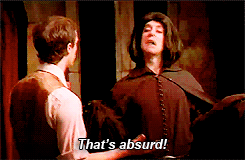10. Making Christmas cookies. We always make sugar cookie cut-outs in the shape of snowmen, trees, bells, gingermen and stars, and frost them with almond or anise-flavored icing. We don't just put sprinkles on the icing - we douse the entire cookie in sprinkles. Bonus: Christmas cookie exchanges where you can trade some of your cookies for a selection of other people's favorites.
9. Counting down with an advent calendar. I'm still a kid at heart, I love to open the little paper windows or look in the pockets each day and see what's inside. Bonus: many German advent calendars have chocolate inside!
8. Christmas tree cutting. If you don't have National Forest nearby where you can go find a tree like we do now, you might have a Christmas tree farm nearby. It's worth the extra effort to get out into the woods and tramp around the woods with a saw, looking for the perfect tree, and then drag it home, drenching your home in spicy piney scent. We do this every other year and sometimes it turns into a real adventure/disaster but that's all part of the fun, too.
7. Rediscovering all the decorations that have been hidden away for a year. It's like seeing old friends again. My mom has a collection of little decorative rocking horses and glass angels. She still has the tree-topper star that I remember unpacking every year and having my dad lift me up to put on the top of the tree. I've started my own collection of nutcrackers and Christmas village pieces. There's always a few that you've forgotten about, until you uncover them.
 |
| my collection of nutcrackers |
6. Wrapping shoeboxes full of toys and goodies for Operation Christmas Child and Angel Tree and local charities. We try to make a big deal about this for our kids to get them just as exciting about giving to others as getting gifts themselves.
5. Singing Christmas carols at bed time. When I was a kid I would go caroling around the neighborhood with my Girl Scout troop, and when my kids are little older I hope to continue that tradition. In the meantime, I started my own tradition of sitting in their room with a flashlight, singing them to sleep out of a book of forty different carols, three carols each night plus one of my three favorites: Have Yourself a Merry Little Christmas, O Holy Night and Silent Night, of course.
4. Evening candle-light services at church. The beautiful flickering light of a hundred candles... and sometimes when church is over and you head outside, there is a layer of new fallen snow - perfect.
3. Driving around to see neighborhood Christmas lights and then coming home to your own lights. When we lived in south for a few years, back before electric lights had become really popular, our neighborhood would line their driveways and sometimes even the streets with luminaria, paper bags weighted with sand, each holding a candle.
2. Getting together with friends and family. The Christmas spirit lends an extra special touch to family gatherings. I'm an only child, so growing up we always had lots of friends over before and after Christmas day. White elephants exchanges and other Christmas games, delicious dinners, Christmas movies (It's a Wonderful Life is my favorite), breaking out the ugly Christmas sweaters...
1. Reading (and sometimes acting out) the story of Jesus' birth and celebrating His birthday. Sometimes this is as simple as setting out a nativity scene and talking about each of the figures. Buying gifts can get stressful, especially if you're on a budget, but the story of the baby born in a stable, laid in manger, always grounds me again and brings a deep abiding peace.
But the angel said to them, “Do not be afraid. I bring you good news that will cause great joy for all the people. Today in the town of David a Savior has been born to you; he is the Messiah, the Lord. This will be a sign to you: You will find a baby wrapped in cloths and lying in a manger.” Luke 2:10-12
Do you have a favorite Christmas or holiday tradition?
























































